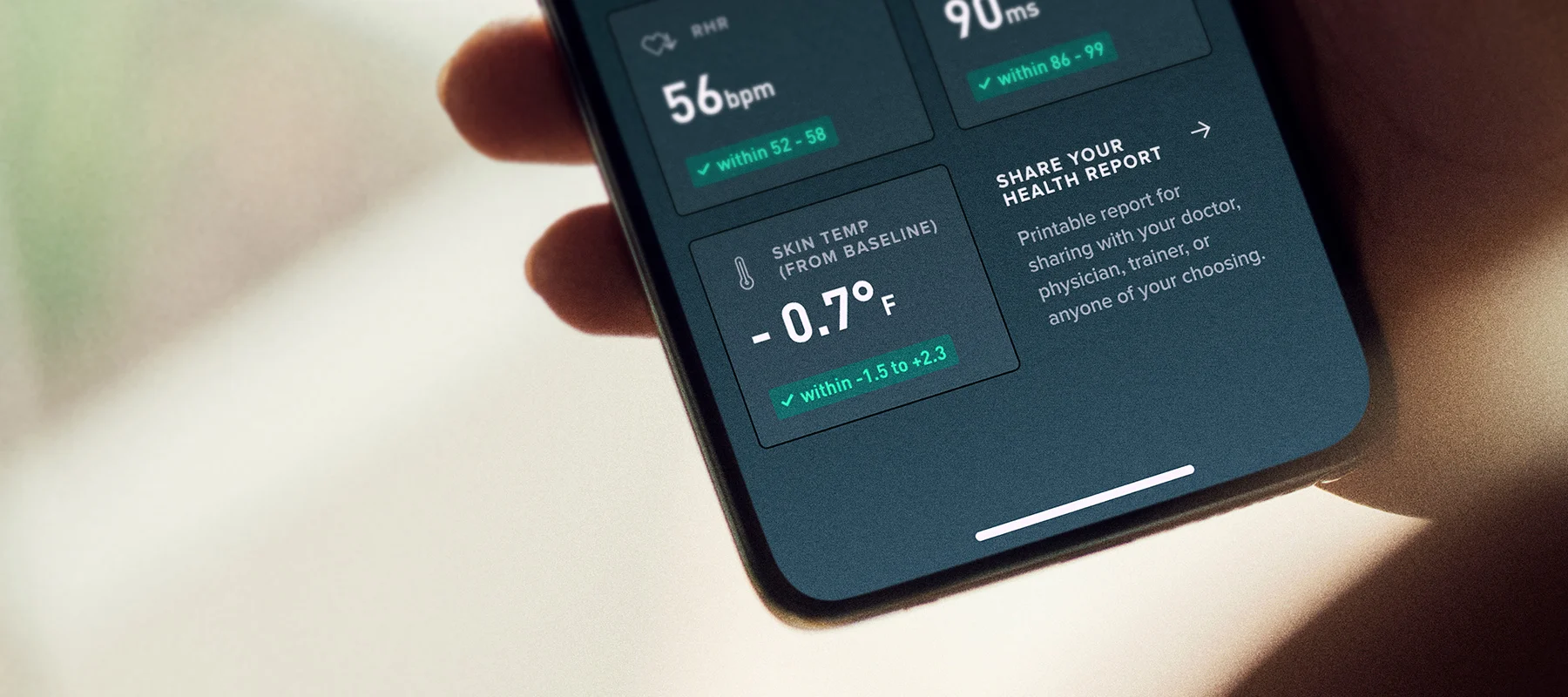Topics
- Article
- App & Features
New WHOOP 4.0 Metric: Skin Temperature

Sensors in WHOOP 4.0 measure your nightly skin temperature for the new Health Monitor. It can help you learn how well you’re sleeping, identify trends and track your overall wellness.
While no external health monitor can track internal body temperature, the skin temperature sensor on the new WHOOP 4.0 tracks your daily skin temperature to give you another layer of knowledge about how ready your body is to perform each day. Skin temperature is one of the new metrics that WHOOP 4.0 monitors daily to provide you with information about your overall wellness.
How WHOOP Monitors Skin Temperature
The WHOOP 4.0 uses a sensor that sits directly above your skin to measure skin temperature. WHOOP builds a personalized baseline for your skin temperature using data from your sleep across the previous 90 nights. Daily variations are shown in the new Health Monitor (more on that to follow) where you can see how skin temperature correlates with other metrics such as live heart rate, blood oxygen levels, heart rate variability, resting heart rate, and respiratory rate. WHOOP will notify you if your skin temperature deviates too far from your typical range. If you have a fever, you can now include that information in the WHOOP Journal so the algorithm can learn more about your personal skin temperature when you are feeling ill.
Where Do I Find Skin Temperature in the App?
Skin temperature is one of the metrics in the WHOOP 4.0 Health Monitor.
When you open the WHOOP app you see an overview of the Health Monitor appearing on the homepage. Clicking on it will bring you to the Health Monitor, which displays your skin temperature. The Health Monitor can also be accessed through the coaching tab on the menu bar at the bottom of your app screen.
What Can Skin Temperature Tell You?
Skin temperature can tell you about how strain and sleep are affecting your recovery. During the evening your core temperature decreases and gives off excess heat through the skin in order to cool for sleep. If your sleep is too hot, your skin temperature may reflect it. This information can help you be more comfortable while you sleep, such as using fewer blankets or an additional fan. Skin temperature can also tell you about microclimates, such as a warm room, heat exposure or if you’re fighting an illness.
Skin Temperature vs Core Temperature

WHOOP 4.0 monitors your skin temperature while you're sleeping.
Your skin has a major role in regulating body heat, also called thermoregulation. For example, during a vigorous workout your body temperature rises. Your sympathetic nervous system senses that rise and causes your skin to sweat, while dilating the capillaries nearest the skin to allow more blood to flow near the skin surface. Sweat evaporates, cooling the skin, which in turn lets the blood within the capillaries cool. That cooled blood then goes back into the core where it absorbs more heat, cooling the body as it does so. These actions combine to help your body lose heat quickly. Conversely, when body temperature drops, the sympathetic nervous system pulls blood into the body’s core and restricts blood flow near the skin to maintain warmth, causing you to shiver. Skin temperature is typically a few degrees lower than core or body temperature, particularly on the wrist or arm where you may normally wear your WHOOP. Skin is exposed to the environment and subject to wind, weather, heating and air-conditioning, and may increase or decrease throughout the day while your core temperature remains normal (98.6 degrees Fahrenheit or 37 Celsius.)
WHOOP Health Monitor
Skin temperature is just one metric you can track with the WHOOP 4.0 Health Monitor. You can see your live pulse rate, respiratory rate, heart rate variability, resting heart rate and blood oximetry in a single location in the WHOOP app. The Health Monitor will also let you know if any of these vitals are outside your normal baseline range. The products and services of WHOOP are not medical devices, are not intended to diagnose COVID-19, the flu or any other disease, and should not be used as a substitute for professional medical advice, diagnosis or treatment. All content available through the products and services of WHOOP is for general informational purposes only.